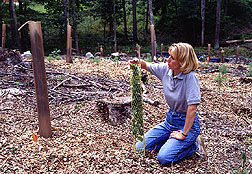Putting Forests on Farms and Farms in Forests
|
|
Eastern Europe may have something to teach America about growing trees--including American trees--on small farms.
Soil scientist Charles M. Feldhake and horticulturist Carol M. Schumann at the Agricultural Research Service Appalachian Soil and Water Conservation Research Laboratory in Beaver, West Virginia, look enviously at the many varieties of American trees, like black locust, that Europeans have selected for livestock browsing and timber and various other purposes.
When East Europeans think of farms, they see a picturesque scene with cows, goats, and sheep mixed in with forests, orchards, and beehives.
Feldhake and Schumann think that's a much more suitable model for the Appalachian hill-lands than the large corn-soybean farms of the Midwest. The steep hills with shallow soils can't take any tillage, so perennials like trees and shrubs are a natural for the area.
Five years ago, Feldhake began growing 1,200 black locust trees on a steep, hilly pasture nestled near the mixed hardwood forest surrounding the lab. The trees are in rows about 30 feet apart in a 5-acre watershed. Currently, 25 sheep graze there. Another 25 graze in an adjacent 5-acre watershed without trees.
"We want to find out whether the trees can reduce nitrogen losses by catching excess nitrogen from livestock urine and manure," Feldhake says. "To check that, we're measuring how much nitrogen leaves the two watersheds in subsoil water and surface runoff."
Feldhake says trees add diversity to a farmer's income. Black locust can be cut and sold for firewood or for pest- and rot-resistant fence posts. The flowers are good nectar sources for honey bees. And during a heat wave, sheep or other livestock can be rotated to the shady, forested pastures.
With black locust, seedling quality has been a problem. Selecting for top-quality black locusts is a low priority with breeders in the United States. "There isn't the commitment to this tree as a crop that there is in a place like Hungary," Feldhake says ruefully.
But the scientists are testing trees and shrubs with better breeding, such as black walnut, honey locust, and sea buckthorn on pastures in West Virginia and at Virginia Polytechnic Institute in Blacksburg, Virginia.
Feldhake says there has been more selection for honey locust trees because of interest in their pods as a good source of sugar and protein for grazing livestock.
European farmers grow the sea buckthorn shrub for its berries, which have a high vitamin content and reputed medicinal value. They make jellies and juices from the berries for home use and roadside sales.
How about growing berries and other fruits and nuts in forests? This past winter, Schumann and Feldhake literally cleared the way for that unique vision, opening up a 1.2-acre strip in the forest. In the spring, they planted red oak tree seedlings. They also planted faster growing trees and shrubs for the short term: white pine, Chinese chestnut, pawpaw, hazelnut, blueberries, and raspberries.
The red oak will be the climax tree in the long term, when it could be selectively cut for high-value veneer. The white pine will be ready for sale as holiday trees beginning December 2006. The pawpaws and chestnuts will bear fruits and nuts beginning as early as 2008, Schumann says.
"We need to find out if we can successfully grow marketable products from the shorter term plantings without negative effects on the red oaks," she says.
"In addition to meeting research objectives, this site is also designed to demonstrate to local farmers that they too can farm with trees and shrubs," Schumann says.--By Don Comis, Agricultural Research Service Information Staff.
Charles M. Feldhake and Carol M. Schumann are at the USDA-ARS Appalachian Farming Systems Research Center, 1224 Airport Rd., Beaver, WV 25813; phone (304) 252-6426, fax (304) 256-2921.
"Putting Forests on Farms and Farms in Forests " was published in the November 1998 issue of Agricultural Research magazine. Click here to see this issue's table of contents.







